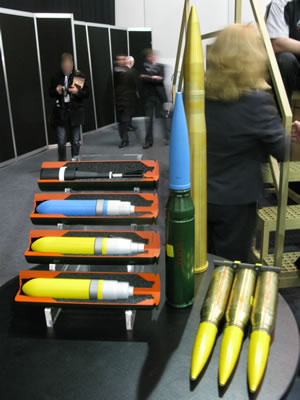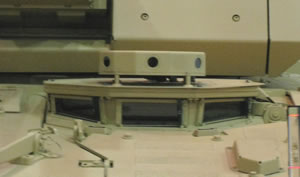BAE Systems unveiled the latest version of the CV-90 medium weight, tracked armored vehicle at the International Armored Vehicles exhibition last week in London. The demonstrator vehicle is proposed as one of two candidates for the FRES Scout Vehicle (FRES SV). The vehicle has been undergoing extensive testing and field trials, part of which is shown on the attached video. The chassis is based on the CV-90, applied with additional modular armor skirts for enhanced side protection. The vehicle carries the MTIP-2 manned turret, employing the CT40 automatic cannon firing case-telescopic rounds and a coaxial machine gun. The turret is also applied with modular armor, designed with attachments similar to the hull. All photos: Noam Eshel, Defense-Update
 The main gun is the CT-40 automatic cannon, firing 40mm case-telescopic rounds. The demonstrator vehicle was displayed with enhanced protection for the barrel and massive protecting for the cradle, eliminating a potential weak point in the vehicle’s frontal arc. Unlike conventional ammunition, the case-telescopic projectile is encased within a cylindrical container packing the propellant. Compared to the current 30mm Rarden gun and 40mm Bofors cannon, the CT-40 offers 30% saving in the weight in volumetric dimension while increasing lethality.
The main gun is the CT-40 automatic cannon, firing 40mm case-telescopic rounds. The demonstrator vehicle was displayed with enhanced protection for the barrel and massive protecting for the cradle, eliminating a potential weak point in the vehicle’s frontal arc. Unlike conventional ammunition, the case-telescopic projectile is encased within a cylindrical container packing the propellant. Compared to the current 30mm Rarden gun and 40mm Bofors cannon, the CT-40 offers 30% saving in the weight in volumetric dimension while increasing lethality.

Also visible on the turret were four electro-optical devices – two fixed day/night sights, the gunner’s main sight that can be slaved to the commander’s line of sight, and the secondary sight coupled with the gun, a third, multi-sensor stabilized observation system can be operated by the commander in a ‘hunter-killer’ configuration as well as for teh vehicle’s primary scout and recce role.
The vehicle on display has not been equipped with all-round vision, but all three crew stations are fitted with large vision blocks, day and night vision systems, covering wide field of view. The commander’s sight used on the vehicle comprises an elevated, stabilized, electro-optical multi-sensor payload which fulfils the vehicle’s primary scout mission. Attached to a fixed assembly well above the turret’s level, this payload provides the crew with clear line of sight for observation and engagement, from defilade positions, maintaining the vehicle relatively protected and combat ready. (Modern scout vehicles have commonly been fitted with more complex telescopic masts carrying the electro-optical system, but this is not the case in this configuration)

The driver shares the same, large three-part vision block similar to those provided to other crew members, providing a wide field of view. An addition three-element Driver Thermal Viewer assembly installed above the driver’s hatch, covering the same field of view provides the driver with continued visibility under limited visibility, at night, through dust, smoke and fog. The driver is also provided with rear-view camera to improve reverse movements.
The vehicle’s electronic systems design is based on open and scalable architecture employing the new standard-based Generic Vehicle Architecture (GVA) – a new technological initiative launched by the British MOD and industry. This architecture was first demonstrated in the Panther and is applied to the CV90 Recce and Warrior Capability Sustainment Program (WCSP) programs.





















